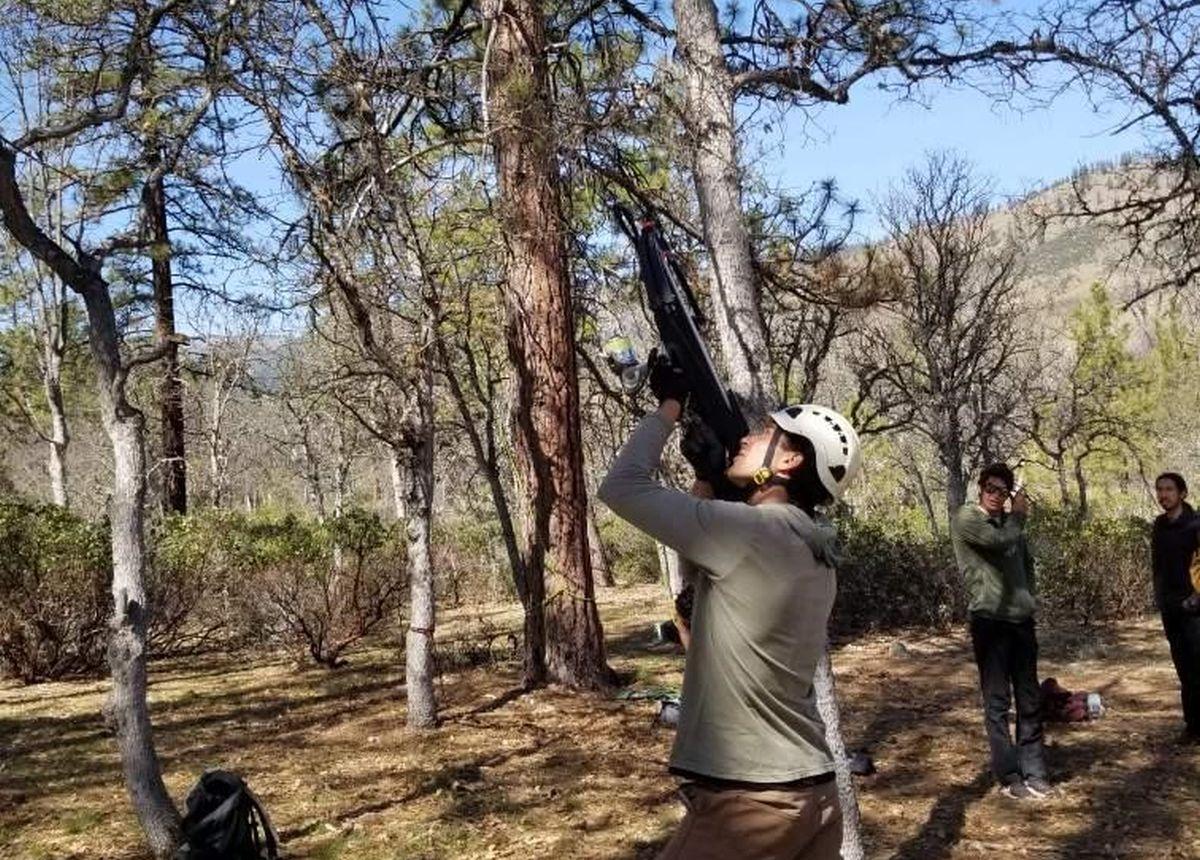Seed Collection Summit
Fri, May 06, 2022

“Oh man oh man, I can’t watch this,” said someone behind my shoulder. At the top of a slender ponderosa pine was Robert Beauchamp moving quickly from branch to branch and narrating his movements. With each movement the tree responded in kind, noticeably bowing this way and that.
Robert is somewhere between the age of 58 and 62 and has been collecting cones of native conifers since the ‘90s. He is a self-proclaimed and externally verified cone-picking machine, with a crusty personality to prove it. He epitomizes the old school, climbing trees with the simplest of equipment including a harness, rope, ascenders, and only a knot for a decent device. He is not alone at this meeting, the remaining 80% of participants are of the same ilk.
The sponsors of this meeting were decidedly NOT old school. DroneSeed and Silva Seed are companies that are teaming up to use modern technology to reforest land after large wildfires with drones. They convened the meeting to introduce all participants to the “regeneration pipeline.” We were in Yreka, a small town in a blue oak-studded valley just north of Mount Shasta so all relevant parties could work to identify how to increase and diversify the native seed bank.
I was there to learn about where Resilient Forestry could potentially be of use for easing constraints on the regeneration pipeline. The two days were filled with different talks from all stages in the process. This included the science behind selecting suitable seed sources in advance of drier and hotter climates, the forest service process of determining their seed needs and issuing contracts, cone crop monitoring, seed cleaning and preparation, nursery planting and rearing, and finally site preparation and tree planting.
I have spent the greater part of my career studying very large trees so it was fun to see so much enthusiasm for such small trees! There was no shortage of interest from all involved, but what became abundantly clear over the course of a few days, is that there was a shortage of seeds and those with the skills to collect them.
The following are my takeaways of the main needs of the industry from the trip and could be potential avenues for Resilient Forestry to get involved:
- There is a huge problem with foresters knowing and being able to communicate what the cone crop is like to collectors, and being able effectively to monitor seeds for ripeness. This could be a fun job requiring climbing or shooting cones out of trees throughout the season. This problem was mentioned so often as a pinch point, that I think it is a huge opportunity.
- There is a shortage of cone collectors. This is a highly skilled job but is often very hard to predict when and where such collectors will be needed. Thus it is either full-on or full-off. Such work is perfect for someone who wants to be an independent contractor but is impractical for employees from both a time and risk management perspective.
- One huge problem is that the contracts do not incentivize collecting cones from trees across a wide geographic or elevational range (climbers are paid by the bushel), and restructuring the contracts is a possible lucrative avenue to pursue
- Contracts could also be restructured so that cone collectors are responsible for cone ripeness monitoring and tracking cone collection locations and amounts, thus having more job security
- At Resilient Forestry, we pride ourselves on our ability to leverage technology, which we can use to modernize cone collection tracking. We can utilize our remote data collection and automated data protocols to better track and monitor the progress of climbing teams to ensure seed is being collected from the full geographic and elevational gradient needed by those trying to reforest.
- Climber training: There is a huge knowledge gap in need and those able to safely climb trees. Many students exiting horticulture programs do not have these skills and they are needed by the forest service and tribes. We can put together some curricula in consultation with the Forest Service to match their certification standards while also providing more information on up-to-date methods and canopy data collection techniques.
The meeting ended with a climbing demonstration which is where I found myself watching Mr. Beauchamp. I was also there to provide his counterpoint by demonstrating the use of modern equipment for tree climbing. While he rocked back and forth like a metronome, I demonstrated how to use my crossbow with mounted fishing reel to enter trees and how to get up and down the rope efficiently. It was fun for me to share something that has always felt like a niche skill and receive so much interest from the seed community. It will be fun to see where this leads…hopefully up a tree somewhere.

